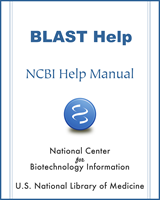BLAST is a Registered Trademark of the National Library of Medicine
NCBI Bookshelf. A service of the National Library of Medicine, National Institutes of Health.
BLAST® Command Line Applications User Manual [Internet]. Bethesda (MD): National Center for Biotechnology Information (US); 2008-.
Sequence similarity searching is one of the more important bioinformatics activities and often provides the first evidence for the function of a newly sequenced gene or piece of sequence. Basic Local Alignment Search Tool (BLAST) is probably the most popular similarity search tool. The National Center for Biotechnology Information (NCBI) first introduced BLAST in 1989. The NCBI has continued to maintain and update BLAST since the first version. In 2009, the NCBI introduced a new version of the stand-alone BLAST applications (BLAST+). The BLAST+ applications have a number of improvements that allow faster searches as well as more flexibility in output formats and in the search input. These improvements include: splitting of longer queries so as to reduce the memory usage and to take advantage of modern CPU architectures; use of a database index to dramatically speed up the search; the ability to save a “search strategy” that can be used later to start a new search; and greater flexibility in the formatting of tabular results.
The functionality of the BLAST+ applications is organized by search type. As an example, there is a “blastp” application that compares proteins queries to protein databases. The “blastx” application translates a nucleotide query in six frames and searches it against a protein database. This organization is different from that of the applications first released in 1997 (e.g., blastall) that supported all types of searches with one application, but it resembles that of the NCBI BLAST web site. An advantage of this design is that each application has only the options relevant to the searches it performs. Additionally, each application can compare a query to a set of FASTA sequences in a file, bypassing the need to create a BLAST database for small and infrequently searched sets. Finally, a “remote” option permits each application to send off a search to the NCBI servers.
This manual has several sections. It provides brief installation instructions, a QuickStart, a section describing BLAST+ features in more depth, a “Cook Book” section on how to perform a number of tasks, as well as three appendices. The first appendix discusses tools to help with the transition from the older applications (e.g., blastall) to the BLAST+ applications. The second appendix documents exit codes from the BLAST+ applications. The third appendix is a table of BLAST options, the type of input required, and the default values for each application. The fourth appendix lists the scoring parameters that the blastn application supports.
An introduction to BLAST is outside the scope of this manual, more information on this subject can be found on http://blast.ncbi.nlm.nih.gov/Blast.cgi?CMD=Web&PAGE_TYPE=BlastDocs.
Please feel free to contact us with any questions, feedback, or bug reports at vog.hin.mln.ibcn@pleh-tsalb.
Contents
- Introduction - BLAST® Command Line Applications User ManualIntroduction - BLAST® Command Line Applications User Manual
Your browsing activity is empty.
Activity recording is turned off.
See more...
